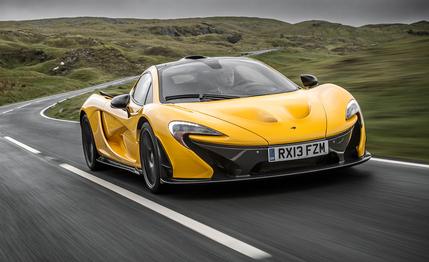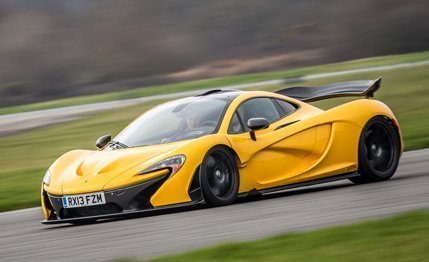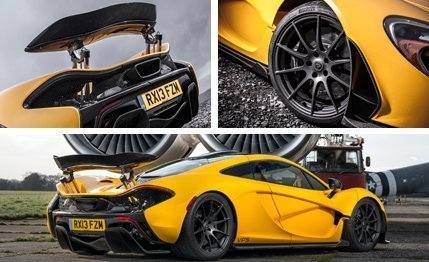
 Instrumented Test
Instrumented Test
Here is a rough transcript of what I uttered when I first unleashed the full 903 horsepower of the McLaren P1: “[Cackle, cackle] Holy [bleep]! That’s . . . [cackle]. I, uh . . . wow. [cackle].”
It was about then that my co-driver reminded me of the pending terminus of the airport runway on which we were driving and the imminent braking zone, which I was now crowding at something like 135 mph. I would tell you our exact speed but, honestly, I haven’t a clue what it was. I never thought to look down at the speedometer. I was by then a speed-drunk sack of cortisol and adrenaline with what I’m guessing were wildly dilated pupils. It wasn’t until much later that remorse would overwhelm me for having used hyperbole in describing other fast cars I’ve driven. I’d wasted all the superlatives on cars that I now know were unworthy.

 The P1 proves once and for all that even an absurdly fast car cannot make a person soil himself. Well, as far as we know.
The P1 proves once and for all that even an absurdly fast car cannot make a person soil himself. Well, as far as we know.
My exposure to the P1, McLaren’s successor to the storied F1 sports car, is four laps of the Dunsfold Aerodrome in Surrey, England, a collection of airport runways and taxiways that’s perhaps better known as the track the British Top Gear television program uses. Four laps to not commit a vehicular and career embarrassment. There was a second P1 circling the track with another Dunsfold virgin behind the wheel. Oh, and the course is configured as a figure eight. Right then, no worries.
Testing confirms the P1 will sprint to 60 mph in 2.7 seconds and continue pulling hard until it reaches its governed top speed of 217 mph. But as impressive as those numbers are, they are not unprecedented in the world of supercars. Hell, a Porsche 911 Turbo S will get to 60 mph in 2.6 seconds, and McLaren’s own F1 achieved a top speed about 20 mph higher back in the ’90s. What is so remarkable about the P1, of which 375 will be made, is its ability to corral a 727-hp twin-turbo V-8, a 177-hp electric motor fed by a lithium-ion battery pack, and a mass of power electronics into a cohesive whole that manages to smoothly and easily deliver a uniquely extreme speed experience.
Do not take that to mean that the car is without drama. It is all drama. Lift off the throttle on corner turn-in and the turbo boost relieves itself with an initially shocking “woof!” You hear air howling as it’s sucked into the roof snorkel, en route to meet its fate in the eight combustion chambers. You hear the low-register rage of the engine, which, even at idle, is incomparably loud for a street car. Pebbles kicked up from the surface ping when they hit the carbon-fiber wheel wells and underside with the crack and clarity of a rifle report. Even when left in automatic mode, the seven-speed dual-clutch transmission pounds through the gears, firm and certain, a couple of milliseconds before you think about shifting.

 Top left: The towering rear wing is absurd and glorious. Top right: Silicon-carbide-coated brake discs laugh at your silly drilled rotors.
Top left: The towering rear wing is absurd and glorious. Top right: Silicon-carbide-coated brake discs laugh at your silly drilled rotors.
But there is no perceptible change of pace when the big turbos get spinning in earnest. You do not notice the electric motor at work. There is just smooth, seamless, seemingly inexhaustible thrust. Any fears that a hybrid system would diminish the enjoyment of the hypercar have been proven, in our minds, to be unfounded—at least in the cases of the McLaren P1 and its fellow mega-hybrids, the Ferrari LaFerrari and Porsche 918, also in this section.
While you can drive the P1 for a claimed six or so miles solely on electricity, the real purpose of the engine-mounted motor is to smooth the power-delivery characteristics of the gasoline engine. McLaren started with a reengineered version of the 3.8-liter V-8 that powers the 650S. With bigger turbos strapped on, and running a healthy 20.3 pounds of boost, the P1’s gas engine is plenty enough propulsion. Each of the engine’s 727 horses is tasked with moving only 4.5 of the P1’s 3300 pounds. And that’s before you add the electric motor’s power to the mix. Meanwhile, a Lamborghini Aventador saddles each of its horses with 5.9 pounds.